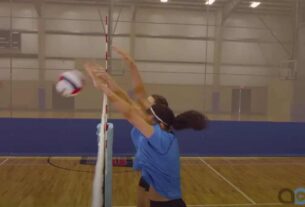Ops in softball refers to the offensive statistic of On-Base Percentage plus Slugging Percentage, which combines a player’s ability to get on base with their power hitting. It is a measure of a player’s overall offensive contribution to the game.
With each at-bat, a player has the opportunity to increase their OPS by reaching base or hitting for extra bases. It is an important metric for evaluating a player’s offensive performance, as a higher OPS indicates a more productive hitter.
What is OPS in Softball
OPS, which stands for On-Base Plus Slugging, is a popular statistic used in softball to measure a player’s hits offensive performance. It is a key indicator of a player’s offensive capabilities. It combines both the player’s ability to get on base and their power hitting, providing a comprehensive measure of their offensive contribution.
The OPS combines two important metrics: on-base percentage (OBP) and slugging percentage (SLG). OBP measures a player’s ability to get on base, including hits, walks, and hits to by pitch, while SLG measures a player’s power and ability to hit for extra bases.
The formula to calculate OPS is:
| OPS | = | OBP | + | SLG |
|---|
A high OPS indicates a player who can both get on base and hit for power, making them a valuable asset to the team’s offense. It is an important statistic for coaches and scouts to evaluate a player’s overall offensive contribution.
OPS can be used to compare players, determine lineup positions, and make strategic decisions during a game. Players who consistently have a high OPS are often considered elite offensive players and can have a significant impact on the outcome of a game.
It is a valuable tool in assessing a player’s offensive abilities and can help in developing strategies to improve a team’s performance.
Calculating OPS In Softball
Calculating OPS in softball is a two-step process. First, you calculate the On-Base Percentage (OBP) and Slugging Percentage (SLG) separately.
To calculate OBP (On-Base Percentage), use the formula:
OBP = (Hits + Walks + Hit by Pitch) / (At Bats + Walks + Hit by Pitch + Sacrifice Flies)
This formula measures a player’s ability to reach base.
SLG = (Singles + (2 * Doubles) + (3 * Triples) + (4 * Home Runs)) / At Bats
Once you have calculated both OBP and SLG, you can find the OPS by adding the two figures together:
OPS = OBP + SLG
Remember, a higher OPS score reflects a player with strong offensive capabilities.
How To Improve OPS In Softball
OPS, or On-Base Plus Slugging, is an important statistic in softball that measures a player’s offensive performance. It combines two key metrics: on-base percentage (OBP) and slugging percentage (SLG). Improving OPS can significantly enhance a player’s effectiveness at the plate.
Strategies for Enhancing On-base Percentage
- Develop strong plate discipline by focusing on pitch selection.
- Practice bunting and slap-hitting techniques to increase opportunities for reaching base.
- Work on improving base-running skills to maximize scoring chances.
- Analyze opposing pitchers and identify their weaknesses to exploit.
Techniques for Increasing Slugging Percentage
- Enhance upper body strength through weight training and resistance exercises.
- Practice hitting for power by incorporating drills that emphasize generating bat speed.
- Develop consistent swing mechanics to optimize power and contact.
- Experiment with different hitting approaches to adapt to various game situations.
Training Tips to Improve Overall OPS
- Engage in regular batting practice sessions to refine hitting skills.
- Work on improving hand-eye coordination through drills and exercises.
- Implement speed and agility training to enhance base-running abilities.
- Seek coaching and feedback to identify areas for improvement and make necessary adjustments.
By implementing these strategies and techniques, players can improve their OPS and become more productive contributors to their softball teams.
Limitations of OPS In Softball
OPS, or On-Base Plus Slugging, is a widely used statistic in softball that combines a player’s on-base percentage (OBP) and slugging percentage (SLG) into a single metric. However, it is important to recognize that OPS has its limitations.
Factors Not Captured By OPS
While OPS provides a valuable overview of a player’s offensive contributions, it does not consider certain factors that can influence a player’s performance. For instance, it does not account for situational hitting, such as a clutch hit in a close game. It also does not consider a player’s ability to steal bases or their defensive skills, which can greatly impact a team’s success.
Contextual Considerations For Interpreting OPS
When analyzing OPS, it is important to consider contextual factors. For example, a higher OPS may be influenced by playing in a hitter-friendly ballpark or facing weaker pitchers. Additionally, OPS alone does not take into account a player’s consistency or their performance against specific types of pitches or in different game situations.
Alternative Statistics To Complement OPS
While OPS provides a valuable snapshot of a player’s overall offensive production, it is useful to consider other statistics to gain a more comprehensive understanding. Metrics like weighted on-base average (wOBA), runs created (RC), or wins above replacement (WAR) can provide additional insights into a player’s value to the team beyond just OPS.

Utilizing OPS In Softball Strategy
OPS serves as an essential tool for coaches and players alike to evaluate offensive performance. By incorporating OPS into game planning, coaches can make tactical decisions that optimize their team’s chances of scoring runs. When determining batting order or making substitutions, coaches can rely on OPS to identify players who consistently find their way on base and deliver powerful hits.
OPS not only provides individual player insights but can also help shape coaching strategies to enhance team performance. For instance, coaches can focus on training techniques that improve both on-base and slugging percentages. They can also devise game tactics to exploit the opponent’s weaknesses based on their pitchers’ OPS, ensuring a well-rounded approach to offensive play.
Ultimately, utilizing OPS in softball strategy enhances decision-making and fosters a competitive advantage. By analyzing and incorporating OPS into game plans, teams can optimize their offensive performance and increase their chances of success on the field.
Comparing Ops To Other Softball Statistics
OPS is an essential softball statistic that helps in evaluating a player’s overall offensive performance. It combines on-base percentage and slugging percentage to provide a more comprehensive view of a player’s effectiveness at the plate.
| OPS vs Batting Average | OPS vs On-base Percentage | OPS vs Slugging Percentage | OPS as a Comprehensive Softball Statistic |
|---|---|---|---|
| Batting Average fails to account for walks and extra-base hits, ignoring the importance of on-base ability and power. | On-base Percentage only considers how often a player reaches base, but doesn’t consider the impact of extra-base hits in scoring runs. | Slugging Percentage focuses solely on a player’s power, neglecting the importance of getting on base. | OPS combines both on-base and slugging percentages, providing a more complete picture of a player’s offensive skills. |
By considering the entire range of offensive contributions, OPS allows coaches, scouts, and analysts to assess a player’s overall offensive value. It helps in comparing and ranking players based on their ability to get on base and hit for power. With OPS, a higher value indicates a more productive offensive player. It is an important tool in evaluating batters and making informed decisions regarding lineups, strategies, and player acquisitions.
Frequently Asked Questions
What Does Ops Stand For In Softball?
Ops in softball stands for On-Base Plus Slugging, a statistic that measures a player’s offensive performance. It combines a player’s ability to reach base (on-base percentage) with their power (slugging percentage) to give a comprehensive measure of their offensive contribution.
How Is Ops Calculated In Softball?
OPS is calculated by adding a player’s on-base percentage (OBP) and slugging percentage (SLG). OBP is the number of times a player reaches base divided by their total plate appearances, while SLG is the total number of bases a player gets divided by their total number of at-bats.
Why Is Ops Important In Softball?
OPS is an important statistic in softball as it gives a more complete picture of a player’s offensive abilities. It takes into account both their ability to reach base and their power, providing a better understanding of their overall offensive impact on the game.
Scouts and coaches often use OPS to evaluate a player’s performance and potential.
Conclusion
Understanding Ops in softball is crucial for players and coaches alike. It provides a comprehensive measure of a player’s offensive performance and can be used to evaluate and compare players across different teams and leagues. By incorporating OPS into their analysis, individuals can gain valuable insights and make informed decisions to improve their team’s overall performance.
So, whether you’re a seasoned player or new to the game, OPS is a metric worth paying attention to.



